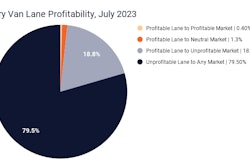We’ve heard many times over the last few weeks and months that the spot and contract markets have either reached bottom or are starting to tick up off the bottom, but even slightly higher than the bottom isn’t anywhere you want to be.
Resilient consumer spending and import activity have helped push rates off the floor as we head into peak season. Spot rates appear to have bottomed out in Q2 but are expected to remain near the bottom in Q3.
Joining Jason and Matt this week is Mazen Danaf, Uber Freight’s senior economist, and he says excess capacity – and how long it’s been able to hang on in this tough environment – has helped keep rates down.
Contents of this video
00:00 Spot and contract markets
01:24 Excess capacity
02:58 COVID’s impact on trucking employment
05:18 Balancing the market
06:07 Peak season
07:32 Manufacturing
08:25 Seasonal patterns
Jason Cannon:
This week's 10-44 is brought to you by Chevron Delo 600 ADF Ultra Low Ash Diesel Engine Oil. It's time to kick some ash.
Trucking additions seem to have hit the bottom, but now what? You're watching, CCJ's 10-44, a weekly episode that brings you the latest trucking industry news and updates from the editors of CCJ. Don't forget to subscribe and hit the bell for notifications so you'll never miss an installment of 10-44.
Hey everybody, welcome back. I'm Jason Cannon and my co-host on the other side is Matt Cole. We've heard a lot over the last few weeks and maybe several months that the spot and contract markets have either reached the bottom or they're starting to kick up a little bit off the bottom, but even slightly higher than the bottom, isn't anywhere you want to be.
Matt Cole:
Resilient consumer spending and import activity have helped push rates off the floor as we head into peak season. Spot rates appear to have bottomed out in Q2 but are expected to remain near the bottom in Q3,
Jason Cannon:
There are some positive indicators that improvement is coming. More carriers are exiting the market and more and in greater numbers are expected to follow suit, if you can even really call that good news. But the manufacturing sector, which is a key driver of freight activity, continues to contract and it's expected to remain in contraction territory for the foreseeable future. Joining us on the 10-44 is Mazen Danaf, Uber Freight senior Economist, and he says that excess capacity and how long it's been able to hang on in this tough environment has helped keep rates down.
Mazen Danaf:
Many were expecting capacity to fall in the market and this is not something that happened. So when we look at several indicators of supply, I like to look at the BLS employment data because I think it's the most predictive of what's happening in the market, particularly spot rates in the truckload market. When we look at that data, it shows that carriers are still hiring. They were still increasing their headcount month over month until recently, until very recently. So if you look at total tracking employment, we're still within half a percentage point of its peak, which was observed earlier in the year. If you look at the subset of that, which is long distance track load employment, we have just hit the peak in May and June decreased slightly after that, but we're still near an all time high. So that's the first data point.
The second data point is what's happening with the FMCSA authorities. The number of carriers that are mostly, that are not captured by the BLS data, which include owner operators. So it's because of the company structure and the type of registration of that company. The BLS data does not capture owner operators. We've seen a lot of owner operators and small fleet exiting the industry there with the FMCSA data. So we've seen a lot of authority revocations exceeding the new authorities granted for tracking. But on the other hand, we didn't see that change reflected in the BLS data, which leads us to think that many of the carriers who exited the market got enrolled with a larger fleet. So it was not a net reduction in capacity, it was just a reallocation of capacity.
Matt Cole:
COVID caused about a 6% drop in long distance trucking employment in 2021, which helped spike rates. Those same robust rates coupled with booming consumer demand drew an army of carriers into the market and led us to where we are now when bundled with crater and consumer demand.
Mazen Danaf:
And after that, carriers were struggling to hire for a long time because all the unemployment insurance and all the government benefits and the stimulus and so on. So they were struggling to bring these drivers back, so we had the crisis of 2021. And then in 2022, we've seen hiring... Late 21 and 2022, hiring became much better. So we have seen a surge of maybe like 9% year over year in 2022 and maybe another 2% year over year since 2022. My expectation is that we're now about 10% or even more than 10% above where we were in 2018 in terms of tracking employment.
Jason Cannon:
The number of carriers is up and demand is down, and there's really no good economic indicators that suggest consumer demand is going to fix this problem anytime soon. That means more carriers have to exit the market to balance it. Just how many? Mazen tells us after a word from 10-44 sponsor from Chevron lubricants.
Protecting your diesel engine and its aftertreatment system has traditionally been a double-edged sword. The same engine oil that is so essential to protecting your engine's internal parts is also responsible for 90% of the ash that is clogging up your DPF and upping your fuel and maintenance costs. Outdated industry thinking still sees a trade-off between engine and emission system protection and Chevron was tired of it, so they spent a decade of R and D developing a no-compromise formulation. Chevron lubricants developed a new ultra low ash diesel engine oil that is specifically designed to combat DPF ASH clogging. DelO 600 ADF with Omnimax technology cuts sulfate ash by a whopping 60%, which reduces the rate of DPF clogging and extends DPF service life by two and a half times. And just think what you can do with all the MPGs you're going to add from cutting your number of regions. Delo 600 ADF isn't just about after treatment. It provides complete protection, extending drain intervals by preventing oil breakdown. Before you had to choose between protecting your engine or your after treatment system, and now you don't 600 ADF from Delo with Omnimax technology, it's time to kick some ash.
Mazen Danaf:
What we need to see, I think, is I'm expecting personally to see a 5% reduction in trucking employment, and that is what will bring the market back to equilibrium. Why am I expecting to see that? Because we have noticed a backward correlation between trucking related rates and employment where the lower trucking rates, the less willing carriers are to higher in the future because their margins are thinner and they're not making as much revenues as before. So based on historical trends, my expectation is that we'll see over the next year, maybe a 4% to 5% reduction in trucking employment, which could bring the market back into equilibrium. My expectation is that it'll be a gradual process from now until 2024, until we get to this 5% correction.
Matt Cole:
We're approaching peak season and last year's peak season never even happened. Mazen expects this year's peak to be better than last year as part of this gradual recovery.
Mazen Danaf:
So my expectation for the rest of this year is that we will see some seasonal uptick in the last two months of the year, but it won't be near where we were in 2021 or early 2022. In fact, most of the forecasts we're looking at, they're not predicting to be back to the 2021 or Q1 2022 levels even in the whole year of 2024 or even in 2025. So these were really exceptional times for the trucking industry that we don't expect to come back in the next two years.
So my expectation is more of a seasonal uptick, not a huge uptick, but the typical seasonal uptake where we see in November, December. Last year we saw a particularly weak November, I think. It was weaker than seasonality. December we saw that uptick, which lasted through January. So that's what we saw last year. This year I expect a similar, maybe a little bit higher uptick, and my expectation is that in Q4, spot rates at least will break even year-over-year. So it'll be like 0% year-over-year breaking this negative year-over-year trend that we saw for the last maybe like 20 months or so.
Jason Cannon:
Weak. Consumer behavior also influences manufacturing, which is a major contributor to the freight economy. But Mazen says correction there is already underway.
Mazen Danaf:
So when we look at manufacturing, we see contraction there. We've seen manufacturing sector has started to contract over the last year. If you look at the ISMPMI, we have seen contraction for maybe almost a year right now. Wholesaler sales, we're seeing a contraction, as well. So sales are lower year over year, and a lot of the weakness in these two sectors, the wholesale and manufacturing, is due to the inventory glut or excess inventories. And as that is resolving gradually, we should expect demand to improve gradually as well. But it doesn't mean the industry has reached the full demand capacity yet. So inventories are still not in the right place, but they're on the right path.
Matt Cole:
The recovery that was supposed to start mid-year this year didn't happen. Some economists have put that off into late 2024 and even 2025. Mazen says improvement is a lot nearer term than that, but the industry might have to adjust its expectations on what it considers improvement.
Mazen Danaf:
My expectation is that if you look at the seasonality patterns, usually we expect weakness in Q1. So every Q1 is usually weaker than Q4. We expect that to be more or less the same. But if you adjust that for seasonality, my expectation is that we will see some increase on a seasonally adjusted basis that should be driven by a reduction in supply and as gradual improvement in the inventory situation.
So yeah, my expectation is that if you look at rates as they are, we'll see them maybe flatten out or decrease slightly, but they might still over outperform seasonality, and my expectation is that rates will be below digits positive year over year.
Jason Cannon:
That's it for this week's 10-44. You can read more on ccjdigital.com. While you're there, sign up for our newsletter and stay up to date on the latest in trucking industry news and trends. If you have any questions or feedback, please let us know in the comments below. Don't forget to subscribe and hit the bell for notifications so you can catch us again next week.











